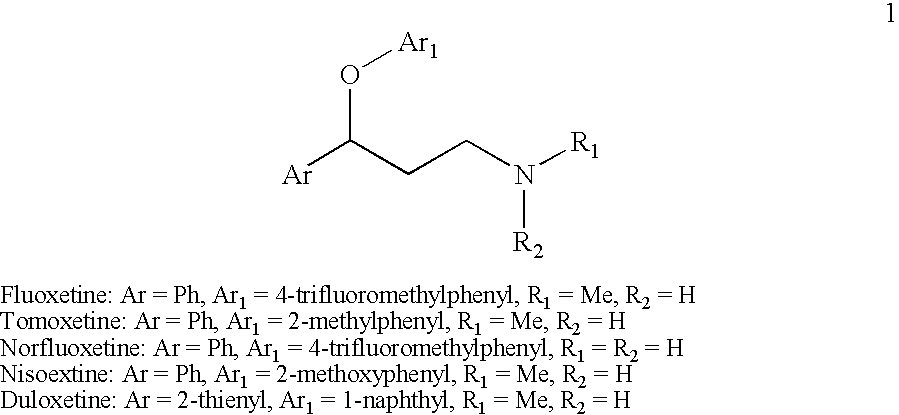Efficient method for preparing 3-aryloxy-3-arylpropylamines and their optical stereoisomers
a technology of arylpropylamine and arylpropylamine, which is applied in the field of process for producing 3aryloxy3arylpropylamine, can solve the problems of high reaction temperature, limited methods, and low to modest yields
- Summary
- Abstract
- Description
- Claims
- Application Information
AI Technical Summary
Benefits of technology
Problems solved by technology
Method used
Image
Examples
example 1
[0076]A solution of (R)-3-chloro-1-phenylpropanol (1.0 g, 5.85 mmol) and a catalytic amount of sodium iodide in ethanol (7 mL) and 40% methylamine aqueous solution (15 mL) was stirred at 60° C. for 7 hours. The reaction mixture was evaporated to 3 mL, and the pH of the solution was adjusted to pH>12 via the addition of aqueous NaOH solution. The mixture was then extracted with toluene twice and the combined extracts were washed with brine. The toluene layer was evaporated to dryness and the residue dissolved in toluene (5 mL) and isopropanol (5.mL) and oxalic acid dihydrate (0.4 g, 3.2 mmol) was added. It was stirred at room temperature for 2Hours and the suspension was filtered and rinsed with toluene / isopropanol to provide 0.9 g of (R)—N-methyl-3-hydroxy-3-phenylpropylamine hemioxalate salt as an off-white solid. 1H NMR (D2O) δ 7.5-7.2 (m, 5H), 4.8 (at, J=6.6 Hz, 1H), 5.15-2.9 (m, 2H), 2.64 (s, 3H), 2.2-2.0 (m, 2H). Elemental Analysis for C11H16NO3; Calculated: H 7.67%; C 62.84%; ...
example 2
[0078]A solution of (R)-3-iodo-1-phenylpropanol (5.0 g, 19 mmol) and catalytic amount of sodium iodide in tetrahydrofuran (20 mL) and 40% aqueous methylamine (40 mL) was stirred at room temperature for 5 hours. The reaction mixture was evaporated to 15 mL and the pH of the solution was adjusted to pH>12 via the addition of aqueous NaOH solution. The mixture was then twice extracted with toluene and the combined extracts were washed with brine. The toluene layer was evaporated to dryness and the residue dissolved in toluene (25 mL) and isopropanol (25 mL) and oxalic acid dihydrate (1.2 g, 9.5 mmol) was added and the mixture was stirred at room temperature for 2 hours. The resulting suspension was filtered and rinsed with toluene / isopropanol to give 3.0 g of (R)—N-methyl-3-hydroxy-3-phenylpropylamine hemioxalate salt as an off-white solid. The solid (2.9 g) was free based with sodium hydroxide solution and extracted with toluene. The extracts were washed with brine and then evaporated...
example 3
[0079]A mixture of (R)—N-methyl-3-hydroxy-3-phenylpropylamine (0.33 g, 2 mmol), 4-iodobenzotrifluoride (0.82 g, 3 mmol), cuprous iodide (0.1 g), cesium carbonate (1.3 g, 4 mmol) and butyronitrile (0.5 mL) was stirred under nitrogen at 130-140° C. until reaction completion as determined by 1H NMR (16-24 hours). The reaction mixture was cooled to room temperature, diluted with methyl t-butyl ether (10 mL), filtered, and rinsed with more methyl t-butyl ether. A 20% HCl solution in isopropanol (1 mL) was added and the resulting solution was evaporated to dryness to give a solid residue. The residue was stirred with methyl t-butyl ether (5 mL) for 1Hour at room temperature and the suspension was filtered and washed with more methyl t-butyl ether to give 0.59 g of (R)—N-methyl-3-(4-trifluoromethylphenoxy)-3-phenylpropylamine hydrochloride ((R)-Fluoxetine hydrochloride) as a white solid [α]D23=−16.1° (c 1, CHCl3). 1H NMR (CDCl3) δ 9.73 (br s, 2H), 7.42 (d, J=8.7 Hz, 2H), 7.4-7.2 (m, 5H), 6...
PUM
| Property | Measurement | Unit |
|---|---|---|
| temperatures | aaaaa | aaaaa |
| temperatures | aaaaa | aaaaa |
| temperatures | aaaaa | aaaaa |
Abstract
Description
Claims
Application Information
 Login to View More
Login to View More - R&D
- Intellectual Property
- Life Sciences
- Materials
- Tech Scout
- Unparalleled Data Quality
- Higher Quality Content
- 60% Fewer Hallucinations
Browse by: Latest US Patents, China's latest patents, Technical Efficacy Thesaurus, Application Domain, Technology Topic, Popular Technical Reports.
© 2025 PatSnap. All rights reserved.Legal|Privacy policy|Modern Slavery Act Transparency Statement|Sitemap|About US| Contact US: help@patsnap.com



